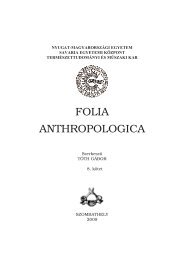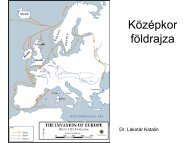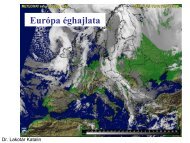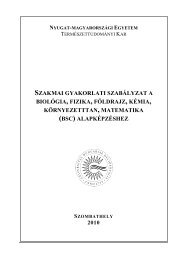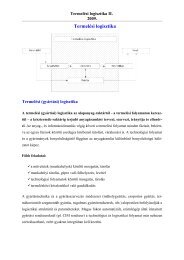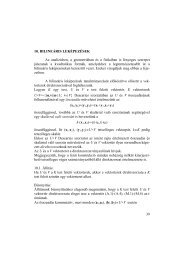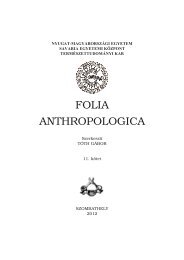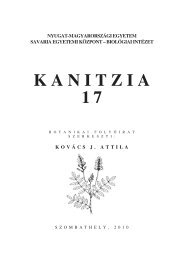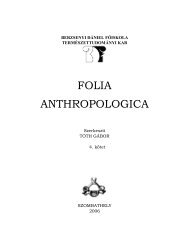Kanitzia 18. - NYME Természettudományi Kar - Nyugat ...
Kanitzia 18. - NYME Természettudományi Kar - Nyugat ...
Kanitzia 18. - NYME Természettudományi Kar - Nyugat ...
Create successful ePaper yourself
Turn your PDF publications into a flip-book with our unique Google optimized e-Paper software.
facing exposition, ancient landslide processes, arid niches, support well the rapid changes<br />
of warming up-drying up processes inducing subdesert-like microclimate and local steppe<br />
conditions on sand, clay and marl substrates. The favourable biological and ecological features<br />
of the species explain his historical succes to colonize altered areas and contribute to<br />
preserve of particular coenotic stands.<br />
As a result of the coenological analysis a new plant community (Agropyro cristati-<br />
Krascheninnikovietum cedratoidis ass. nova), was described with presponderant continental<br />
and pontic characteristics, given by the dominant stands (K. ceratoides) and the xerothermic<br />
diagnostic species groups (Krascheninnikovia ceratoides, Agropyron cristatum,<br />
Artemisia campestris agg., Artemisia austriaca, Artemisia pontica, Brassica elongata, Astragalus<br />
monspessulanus) which indicate transitional characteristics between the Artemisio-Kochion<br />
s. l. and Festucion rupicolae alliances. The new plant community has close<br />
coenotic and ecologic relationships with the Artemisietum pontico-campestris (Transylvanian<br />
Basin) and with the Agropyro cristati-Kochietum prostratae (Pannonian Basin).<br />
Stabilized coenotic stands of K. ceratoides were reported from the disturbed dry glasslands<br />
(Bothriochloetum ischaemi, Potentillo arenariae-Stipetum capillatae) also. Small and rare<br />
populations of K. ceratoides can be found in other steppic meadows, and eroded dry grasslands<br />
(Stipetum pulcherrimae, Stipetum lessingianae, Cariceto humilis-Festucetum rupicolae,<br />
Artemisietum pontico-campestris, Artemisietum campestris-Agropyretum<br />
intermedii). In addition K. ceratoides can create recurrent fragmentary stands with other<br />
eroded land-colonizing species like: Elymus hispidus, Calamagrostis epigeios or with various<br />
weeds.<br />
It can be concluded that the species K. ceratoides with a large biological adaptability<br />
present a great resistency to the continuous natural landslide processes, site erosion<br />
and fragmentation, but supports less the annual vegetation burning, the intensive grazing<br />
pressure, clearings, strong afforestations, different agricultural and economic interventions.<br />
Therefore the species surviving in the habitats and plant communities investigated must<br />
be considered as vulnerable, so for these particular steppic vegetation, as a relic enclave of<br />
the Holocene vegetation history, it would be necessary to apply a saving and protection<br />
regime using the ’European priority habitats’ and the Transylvanian IPA-system also.<br />
Acknowledgement<br />
The study was supported by the Grant of TAMOP-4.2.1/B-09/-2010 University of<br />
West Hungary, Faculty of Natural Sciences. The author are greatfully aknowledge to L. PÓLYA<br />
(Debrecen) and I. DANCZA (Budapest) for their scientific remarks, to J. BÜKI (Budapest) for<br />
bibliographic data and to B. KEDVES and L. MÉSZÁROS for the field investigations.<br />
REFERENCES<br />
ADLER W., OSWALD K., FISCHER R. (Eds.) (1994): Excursionflora von Österreich. – Verlag<br />
Eugen Ulmer, Wien.<br />
AELLEN P. (1967): Krascheninnikovia Gueldenst. In: Flora of Turkey and East Aegyan Islands<br />
Vol.2. P. H. Davis Ed. 313p. - Edinburg Univ. Press.<br />
73




